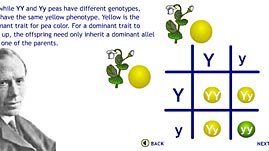Teachers' Domain - Digital Media for the Classroom and Professional Development
User: Preview

Source: Cold Spring Harbor Laboratory, Dolan DNA Learning Center
This interactive activity, adapted from the Dolan DNA Learning Center, illustrates how a tool developed by scientist Reginald Punnett — the Punnett square — validates Gregor Mendel's laws of genetic inheritance. Watch how the Punnett square can be used to display the possible genetic outcomes when two yellow-seed hybrid pea plants are crossed. The results clearly illustrate Mendel's principle of dominance and why the potential offspring traits appear with a predictable 3-to-1 dominant-to-recessive frequency.
Modern genetics is founded on three principles that explain how traits for physical characteristics such as height and coloration are transmitted from one generation to the next. These principles were first explained by Gregor Mendel, a Moravian monk, in the 1850s. Mendel performed experiments using common pea plants. He observed inheritance patterns that arose when he mated, or crossed, parents with known genetic traits, and then allowed subsequent generations of offspring to self-pollinate. The hereditary mechanisms derived from the results of these experiments can be applied to other complex living organisms, including humans.
Mendel's first main conclusion concerned dominance. He observed that crossing parent plants with pure lines—one with green peas, the other with yellow—produced offspring that were always either green or yellow, and not a blend. He also found that yellow peas appeared more often than green peas in a predictable 3-to-1 frequency in the subsequent generation. Mendel called the more common traits "dominant" and the less common ones "recessive."
According to Mendel's second principle, called the principle of segregation, each parent contributes one and only one allele, or part of a gene pair, to an egg or sperm. When fertilization occurs, the offspring's gene pair is determined by which allele each sex cell carried. The allele that gets segregated, or separated, from each parent's pair is a matter of chance. So, for a given trait such as pea color, a hybrid (heterozygous) parent that carries two different alleles would contribute either the dominant allele (for yellow color) or the recessive one (for green color). A purebred (homozygous) parent that carries two identical alleles could only contribute the allele for that trait.
Finally, Mendel's third principle, the principle of independent assortment, states that the pairs of alleles needed for each trait are passed on to offspring independently of one another. This means that offspring can possess combinations of genes that neither parent possesses. For example, because the inheritance of flower color has no effect on the inheritance of seed color, a white-flowered plant that produces green peas can descend from white-flowered parents (or a white-flowered parent, if self-pollinating) that produced yellow peas.
These three principles account for the many combinations of traits seen over several generations of offspring. The fact that some human traits are controlled by more than one gene pair adds even more complexity. Siblings may share a few traits in common, such as hair color and handedness. But they are not likely to share all of their traits, including other hair characteristics (e.g., straightness or curliness), eye color, and height.
 Loading Standards
Loading Standards Teachers' Domain is proud to be a Pathways portal to the National Science Digital Library.
Teachers' Domain is proud to be a Pathways portal to the National Science Digital Library.
